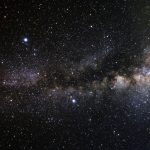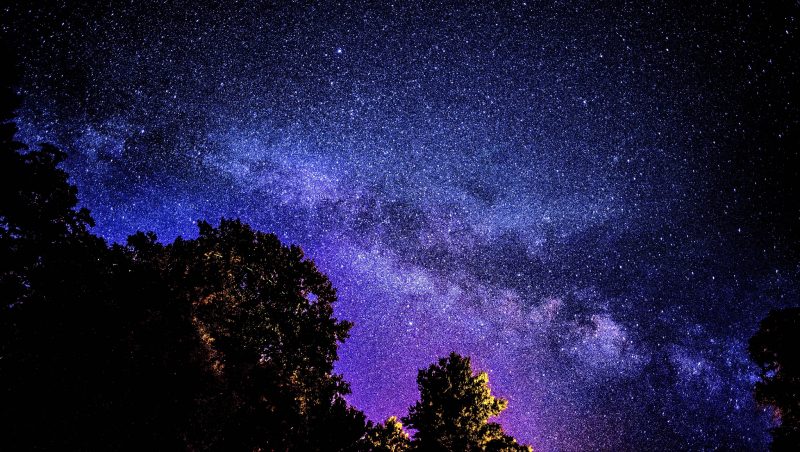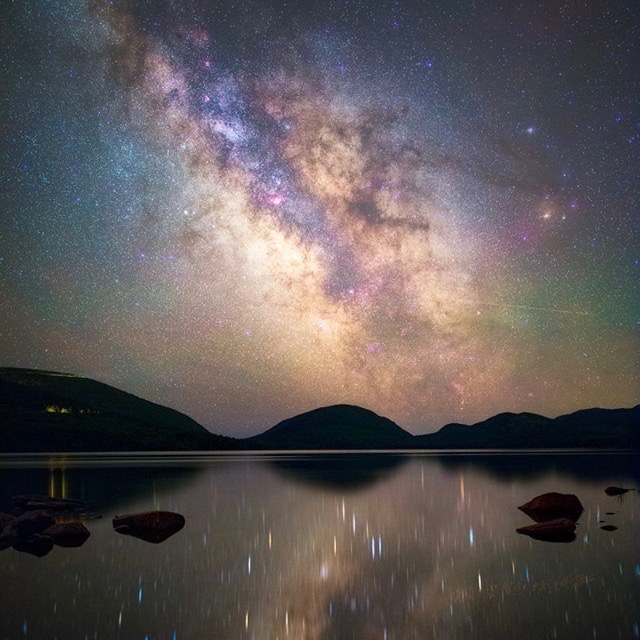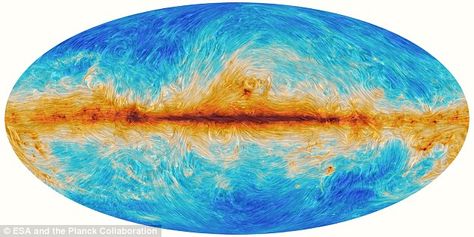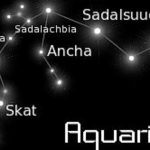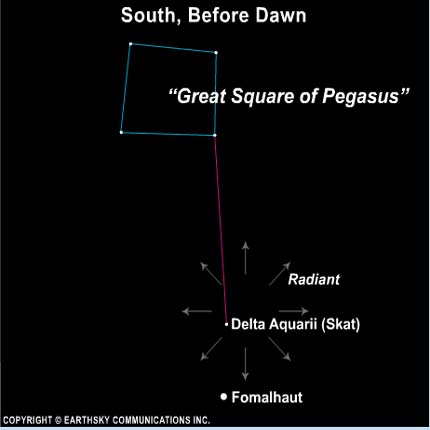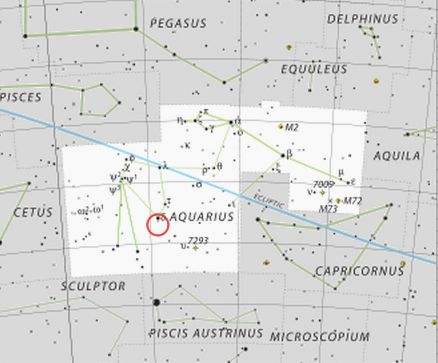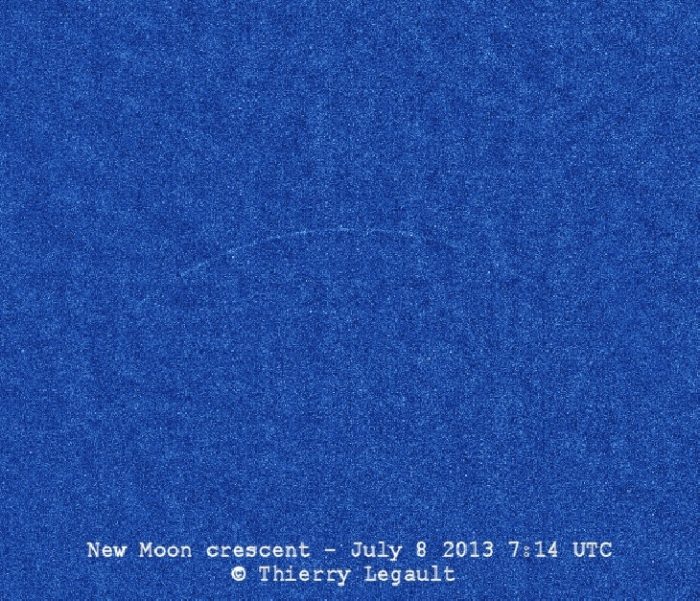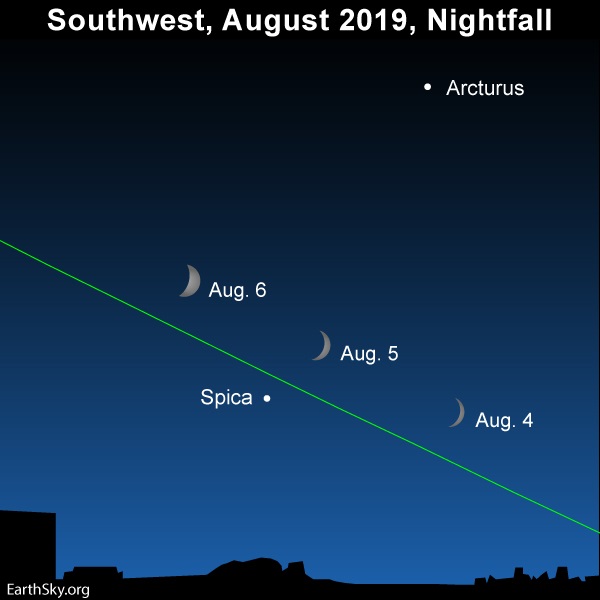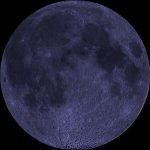
Image at top via EarthView.
Depending on where you live worldwide, the new moon falls on July 31 or August 1, 2019. Same new moon … different time zones. Thus this new moon is either the second of two July 2019 new moons. Or it’s the first of two August 2019 new moons. Either way, the second of two new moons in one calendar month is sometimes called a Black Moon. Here, in the United States, the Black Moon – July’s second new moon – falls on July 31. In the world’s Eastern Hemisphere, a Black Moon falls in late August.
You can’t see a new moon. It travels across the sky with the sun during the day. But the gravitational influence of the new moon and sun combine to physically affect our water planet, which people along the ocean coastlines may notice in the coming days.
Moreover, this new moon is a supermoon, that is, a new moon happening in close conjunction with lunar perigee – the moon’s closest point to Earth in its monthly orbit. Don’t listen to curmudgeon-y old astronomers telling you supermoons are “hype.” Supermoons aren’t hype; the name has arisen from folklore, like Blue Moon or Black Moon or the beloved Harvest Moon.
And, although you can’t see a new supermoon (because it’s in the sun’s glare), a new supermoon’s impact is real and profound. The tidal force of the extra-close new moon and the sun team up to usher in extra-large spring tides, where the variation in high and low tide is especially great. High spring tides typically follow the new or full moon by a day or so; as always, the variation in your local tide will depend on a number of factors, including the weather and the shape of your coast.
In any case, spring tides – especially the large spring tides caused by supermoons – are in stark contrast to even-keeled neap tides, when there’s a minimal variation between high and low tide, around the time of the first and last quarter moon.
So supermoons – particularly close new or full moons – increase the range between high and low spring tides all the more. Spring tides are not named for the season, by the way, but in the sense of jump, burst forth, or rise.
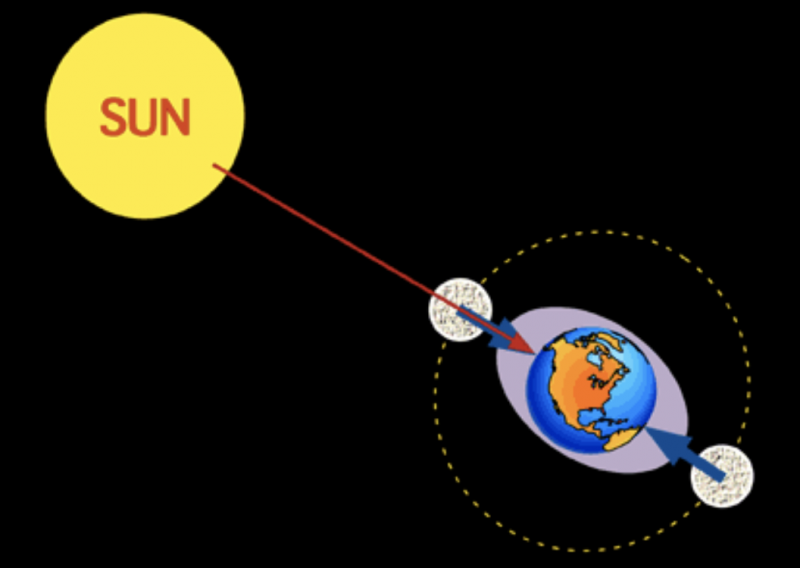
Supermoons affect earthly tides. A day or so after every new moon and full moon – when the sun, Earth, and moon are located more or less on a line in space – the whole Earth has its highest and lowest tides. These are called “spring tides.” A supermoon – close moon at the new or full phase – will accentuate the range between high and low tides even more. Image via physicalgeography.net. Read more: Tides, and the pull of the moon and sun.
The exact time of this new moon is August 1 at 03:12 Universal Time. Although the new moon comes at the same instant worldwide, our clocks read differently by time zone. At North American and U.S. time zones, the new moon instant falls on August 1, at 12:12 a.m. ADT – yet on July 31 at 11:12 p.m. EDT, 10:12 p.m. CDT, 9:12 p.m. MDT, 8:12 p.m. PDT, 7:12 p.m. AKDT, and 5:12 p.m. HST.
At new moon, the moon swings (more or less) between the Earth and sun, to transition from the morning to evening sky. Around new moon, the moon is lost in the sun’s glare for a day or two. Expect to see the moon next in the western evening sky after sunset. You might see it as soon as August 2, for example.

How much bigger is a supermoon? Above, Peter Lowenstein superimposed a mini-moon (full moon at apogee, its farthest from Earth for that month) on a young crescent moon (covered over in earthshine) near perigee, its closest to Earth for that month. The size difference is proportionally similar to that of a U.S. quarter versus a U.S. nickel.
The astrologer Richard Nolle is credited for coining the word supermoon. That’s probably one reason some astronomers object to it, although others embrace it as a simpler and catchier name than perigean new or full moon, which is what we called these moons before the term supermoon came along. Nolle defined a supermoon as:
… a new moon or full moon at or near (within 90 percent) of its closest approach to earth in a given orbit.
The moon in its orbit comes closest to Earth at perigee and swings farthest from Earth at apogee. At apogee, the moon is at 0 percent of its closest distance to Earth; and at perigee, it’s at 100 percent of its closest distance to Earth. A new or full moon aligning with perigee is about 30,000 miles (50,000 km) closer to Earth than a new or full moon aligning with apogee.
Based on Nolle’s definition of a supermoon, the relative nearness of the next three new moons gives us a “season” of new supermoons:
New moon distance (2019 Aug 01): 224,074 miles or 360,612 km
New moon distance (2019 Aug 30): 221,971 miles or 357,227 km
New moon distance (2019 Sep 28): 222,596 miles or 358,233 km
Source: The Moon Tonight
By the way, this year’s farthest new moon happened on February 4, 2019, when it was a whopping 252,566 miles (406,466 km) away. This new moon micro-moon took place one fortnight (approximately two weeks) after the full moon supermoon of January 21 and one fortnight before the full moon supermoon of February 19, 2019.
And guess what? The year’s farthest and smallest full moon (micro-moon) will occur on September 14, 2019, exactly one fortnight after the new moon supermoon of August 30 and one fortnight before the new moon supermoon of September 28, 2019.
In fact, the July 31-August 1, 2019, new moon will present the first in a series of three straight new moon supermoons, to fall (by Universal Time) on August 1, August 30, and September 28.

Here’s another far moon/near moon comparison between the December 3, 2017 close full moon and 2017’s farthest full moon in June by Muzamir Mazlan at Telok Kemang Observatory, Port Dickson, Malaysia.
Bottom line: Depending on where you live worldwide, this new moon happens on July 31 or August 1. It is either the second of two July 2019 new moons, or the first of two August 2019 new moons, depending on your time zone. By popular decree, the second of two new moons in one calendar month is called a Black Moon. This July 31/August 1 new moon is also a supermoon.
from EarthSky https://ift.tt/2yotMWL

Image at top via EarthView.
Depending on where you live worldwide, the new moon falls on July 31 or August 1, 2019. Same new moon … different time zones. Thus this new moon is either the second of two July 2019 new moons. Or it’s the first of two August 2019 new moons. Either way, the second of two new moons in one calendar month is sometimes called a Black Moon. Here, in the United States, the Black Moon – July’s second new moon – falls on July 31. In the world’s Eastern Hemisphere, a Black Moon falls in late August.
You can’t see a new moon. It travels across the sky with the sun during the day. But the gravitational influence of the new moon and sun combine to physically affect our water planet, which people along the ocean coastlines may notice in the coming days.
Moreover, this new moon is a supermoon, that is, a new moon happening in close conjunction with lunar perigee – the moon’s closest point to Earth in its monthly orbit. Don’t listen to curmudgeon-y old astronomers telling you supermoons are “hype.” Supermoons aren’t hype; the name has arisen from folklore, like Blue Moon or Black Moon or the beloved Harvest Moon.
And, although you can’t see a new supermoon (because it’s in the sun’s glare), a new supermoon’s impact is real and profound. The tidal force of the extra-close new moon and the sun team up to usher in extra-large spring tides, where the variation in high and low tide is especially great. High spring tides typically follow the new or full moon by a day or so; as always, the variation in your local tide will depend on a number of factors, including the weather and the shape of your coast.
In any case, spring tides – especially the large spring tides caused by supermoons – are in stark contrast to even-keeled neap tides, when there’s a minimal variation between high and low tide, around the time of the first and last quarter moon.
So supermoons – particularly close new or full moons – increase the range between high and low spring tides all the more. Spring tides are not named for the season, by the way, but in the sense of jump, burst forth, or rise.

Supermoons affect earthly tides. A day or so after every new moon and full moon – when the sun, Earth, and moon are located more or less on a line in space – the whole Earth has its highest and lowest tides. These are called “spring tides.” A supermoon – close moon at the new or full phase – will accentuate the range between high and low tides even more. Image via physicalgeography.net. Read more: Tides, and the pull of the moon and sun.
The exact time of this new moon is August 1 at 03:12 Universal Time. Although the new moon comes at the same instant worldwide, our clocks read differently by time zone. At North American and U.S. time zones, the new moon instant falls on August 1, at 12:12 a.m. ADT – yet on July 31 at 11:12 p.m. EDT, 10:12 p.m. CDT, 9:12 p.m. MDT, 8:12 p.m. PDT, 7:12 p.m. AKDT, and 5:12 p.m. HST.
At new moon, the moon swings (more or less) between the Earth and sun, to transition from the morning to evening sky. Around new moon, the moon is lost in the sun’s glare for a day or two. Expect to see the moon next in the western evening sky after sunset. You might see it as soon as August 2, for example.

How much bigger is a supermoon? Above, Peter Lowenstein superimposed a mini-moon (full moon at apogee, its farthest from Earth for that month) on a young crescent moon (covered over in earthshine) near perigee, its closest to Earth for that month. The size difference is proportionally similar to that of a U.S. quarter versus a U.S. nickel.
The astrologer Richard Nolle is credited for coining the word supermoon. That’s probably one reason some astronomers object to it, although others embrace it as a simpler and catchier name than perigean new or full moon, which is what we called these moons before the term supermoon came along. Nolle defined a supermoon as:
… a new moon or full moon at or near (within 90 percent) of its closest approach to earth in a given orbit.
The moon in its orbit comes closest to Earth at perigee and swings farthest from Earth at apogee. At apogee, the moon is at 0 percent of its closest distance to Earth; and at perigee, it’s at 100 percent of its closest distance to Earth. A new or full moon aligning with perigee is about 30,000 miles (50,000 km) closer to Earth than a new or full moon aligning with apogee.
Based on Nolle’s definition of a supermoon, the relative nearness of the next three new moons gives us a “season” of new supermoons:
New moon distance (2019 Aug 01): 224,074 miles or 360,612 km
New moon distance (2019 Aug 30): 221,971 miles or 357,227 km
New moon distance (2019 Sep 28): 222,596 miles or 358,233 km
Source: The Moon Tonight
By the way, this year’s farthest new moon happened on February 4, 2019, when it was a whopping 252,566 miles (406,466 km) away. This new moon micro-moon took place one fortnight (approximately two weeks) after the full moon supermoon of January 21 and one fortnight before the full moon supermoon of February 19, 2019.
And guess what? The year’s farthest and smallest full moon (micro-moon) will occur on September 14, 2019, exactly one fortnight after the new moon supermoon of August 30 and one fortnight before the new moon supermoon of September 28, 2019.
In fact, the July 31-August 1, 2019, new moon will present the first in a series of three straight new moon supermoons, to fall (by Universal Time) on August 1, August 30, and September 28.

Here’s another far moon/near moon comparison between the December 3, 2017 close full moon and 2017’s farthest full moon in June by Muzamir Mazlan at Telok Kemang Observatory, Port Dickson, Malaysia.
Bottom line: Depending on where you live worldwide, this new moon happens on July 31 or August 1. It is either the second of two July 2019 new moons, or the first of two August 2019 new moons, depending on your time zone. By popular decree, the second of two new moons in one calendar month is called a Black Moon. This July 31/August 1 new moon is also a supermoon.
from EarthSky https://ift.tt/2yotMWL







